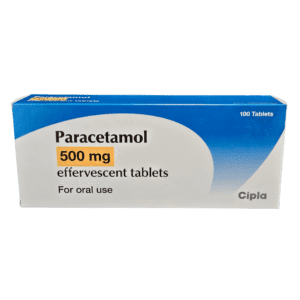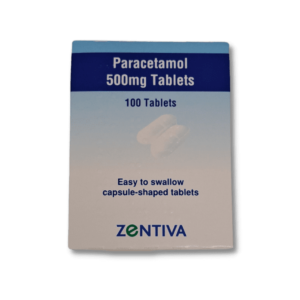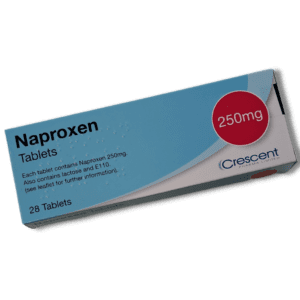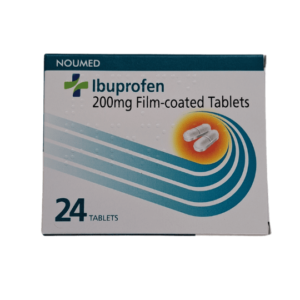- Mon - Fri: 9:00 - 17:00
- 01493 600610
Convenient and confidential pain relief medication consultation
- Experienced UK-based clinician
- Safe, secure & confidential service
- Treatment with comfort
Pain management.
You can buy non-steroidal anti-inflammatory drugs (NSAIDS) such as naproxen 250mg tablets, and paracetamol 100 pack online from our OnlineChemist private doctor. Simply complete the online consultation below and order, our clinician will privately prescribe the medication if suitable and OnlineChemist will dispense and dispatch that for you.
Pain relief treatment options.
-
- Pain Relief
Nefopam tablets 30mg
- £23.99 – £45.99
-
- Pain Relief
Naproxen tablets
- £8.00 – £12.00
-
- Pain Relief
Ibuprofen tablets
- £1.49 – £6.49
Pain Relief Medications
Pain relief medications, also known as analgesics, are drugs used to relieve pain. They work by blocking pain signals from reaching the brain or by reducing inflammation. Here are some of the most common types of pain relief medications:
- Paracetamol: This is a common pain reliever that is used to treat mild to moderate pain. It is available over-the-counter and is often used to treat headaches, muscle aches, and toothaches. Paracetamol is generally safe when taken as directed, but it can cause liver damage if taken in high doses.
- Nonsteroidal anti-inflammatory drugs (NSAIDs): This class of drugs includes aspirin, ibuprofen, and naproxen. NSAIDs work by reducing inflammation and are used to treat pain from conditions such as arthritis, menstrual cramps, and muscle strains. NSAIDs can cause stomach bleeding and other serious side effects if taken in high doses or for a long period of time.
- Opioids: Opioids are strong pain relievers that are used to treat severe pain. Examples include morphine, codeine, and oxycodone. Opioids work by binding to receptors in the brain and spinal cord, blocking pain signals. They can be highly addictive and can cause serious side effects such as respiratory depression.
- Topical pain relievers: These are creams, gels, or patches that are applied directly to the skin to relieve pain. They work by numbing the area or by reducing inflammation. Topical pain relievers are often used to treat localized pain, such as from arthritis or muscle strains.
- Antidepressants: Some types of antidepressants, such as duloxetine and amitriptyline, can be used to treat chronic pain. They work by altering the levels of certain chemicals in the brain and spinal cord that are involved in pain signalling.
Don’t let pain control your life. Take control with our pain management service
Important Note: Painkillers
- Some pain relief medications can also be purchased online in the UK, but it’s important to be cautious when purchasing medications from online sources. Make sure to only purchase medications from reputable sources and to check that the medication is licensed for use in the UK. Buy from OnlineChemist.
- In addition to prescription and over-the-counter medications, there are also complementary therapies that can be used to manage pain. These include acupuncture, massage, and relaxation techniques. It’s important to talk to your healthcare provider before trying any complementary therapies, as they may interact with medications or be contraindicated for certain medical conditions.
- If you have chronic pain, your healthcare provider may recommend a pain management program. These programs typically involve a combination of medications, therapies, and lifestyle changes to help manage pain and improve quality of life.
- If you are pregnant or breastfeeding, some pain relief medications may not be safe to use. It’s important to talk to your healthcare provider before taking any medications during pregnancy or while breastfeeding.
- Over-the-counter pain relief medications are typically safe when used as directed, but they can cause side effects in some people. These can include stomach upset, dizziness, and drowsiness. If you experience any side effects, stop taking the medication and talk to your healthcare provider.
- It’s important to store pain relief medications safely, out of the reach of children and pets. Some medications can be toxic if ingested in large quantities. If you suspect that a child or pet has ingested a medication, seek medical attention immediately.
- Strong opioids such as morphine and fentanyl are only available on prescription and are typically used to treat severe pain, such as that associated with cancer or after surgery.
- In addition to topical pain relievers, there are other topical treatments that can be used to relieve pain. For example, lidocaine patches can be applied to the skin to numb the area and reduce pain.
- For some types of pain, other types of medications may be more appropriate. For example, muscle relaxants such as diazepam may be used to treat muscle spasms, while anticonvulsants such as gabapentin may be used to treat nerve pain.
Pregnant and Breastfeeding:
if you are pregnant or breastfeeding, there are some things to keep in mind when taking pain relief medications. Here are some general guidelines:
- Always talk to your healthcare provider before taking any medications during pregnancy or while breastfeeding. Some medications can be harmful to developing foetuses or infants, so it’s important to get advice from a healthcare professional.
- Some pain relief medications, such as NSAIDs, should be avoided during pregnancy and breastfeeding. These medications can increase the risk of bleeding and other complications during pregnancy, and can be passed to infants through breast milk.
- Paracetamol is generally considered safe for use during pregnancy and breastfeeding, but should still be used with caution. Be sure to follow the recommended dosage and talk to your doctor or pharmacist if you have any concerns.
- Opioid medications should be used with caution during pregnancy and breastfeeding, as they can be habit-forming and lead to dependence or withdrawal in infants. If you are taking opioid medications, talk to your doctor or pharmacist about the potential risks and benefits.
- Some topical pain relief medications, such as lidocaine patches or creams, may be safe to use during pregnancy and breastfeeding. However, it’s important to talk to your healthcare provider before using any topical medications.
- Complementary therapies such as acupuncture, massage, and relaxation techniques may be safe to use during pregnancy and breastfeeding.
Contraindications:
There are some contraindications for pain relief medications. Contraindications are medical reasons why a person should not take a particular medication. Here are some examples:
- Allergic reaction: If you have had an allergic reaction to a pain relief medication in the past, you should not take it again.
- Pre-existing medical conditions: Certain medical conditions, such as liver disease, kidney disease, or stomach ulcers, can make it unsafe to take certain pain relief medications. Your doctor will consider your medical history and any pre-existing conditions before prescribing or recommending a pain relief medication.
- Drug interactions: Some pain relief medications can interact with other medications, including over-the-counter medications, prescription medications, and supplements. Be sure to inform your GP or pharmacist about all medications you are taking before starting a new pain relief medication.
- Pregnancy and breastfeeding: As mentioned earlier, some pain relief medications should be avoided during pregnancy and breastfeeding due to potential risks to the developing foetus or infant.
- Age: Certain pain relief medications may be unsafe for older adults or children. Be sure to follow dosage instructions carefully and talk to your healthcare provider if you have any concerns.
As always, it’s important to talk to your GP or pharmacist before taking any medications to ensure that they are safe and appropriate for your individual needs. They can help you weigh the potential risks and benefits of pain relief medications and other interventions.
More Information: Pain Relief Medications
- NHS Choices: Painkillers https://www.nhs.uk/medicines/painkillers/
- NHS Inform: Painkillers https://www.nhsinform.scot/illnesses-and-conditions/injuries/painkillers
- Medicines and Healthcare products Regulatory Agency (MHRA) https://www.gov.uk/government/organisations/medicines-and-healthcare-products-regulatory-agency
- Royal College of Obstetricians and Gynaecologists (RCOG): Pain relief in labour https://www.rcog.org.uk/en/patients/patient-leaflets/pain-relief-in-labour/
- Patient.info: Painkillers https://patient.info/medicines/painkillers-leaflet
Don't let pain hold you back from doing the things you love! Need stronger pain relief?
Start a free consultation now!
FAQs
There are several types of pain relief medications available in the UK, including paracetamol, non-steroidal anti-inflammatory drugs (NSAIDs), opioids, and other prescription painkillers. Some medications, such as paracetamol and ibuprofen, are available over-the-counter, while others require a prescription from a healthcare provider.
There are several non-pharmacological approaches to pain management that can be effective, including physical therapy, exercise, relaxation techniques, massage, acupuncture, and cognitive behavioural therapy. Talk to your healthcare provider about incorporating these approaches into your pain management plan.
Some natural remedies, such as herbal supplements, heat therapy, and meditation, may provide relief for some types of pain. However, it’s important to talk to your healthcare provider before trying any new natural remedies, as they may interact with other medications or health conditions.
The duration of pain relief medication use depends on the type of medication and the underlying cause of the pain. For acute pain, such as pain following surgery or injury, pain relief medication is typically used for a short period of time. For chronic pain, ongoing pain relief medication may be necessary. Talk to your pharmacist about the appropriate duration of pain relief medication use for your individual needs.
The NHS offers a range of pain management programs and services, including physical therapy, cognitive behavioural therapy, and medication management. These programs are typically provided through pain clinics and multidisciplinary teams. For more information – NHS pain management.
The side effects of pain relief medications can vary depending on the type of medication and individual factors such as age, health status, and dosage.
Common side effects of opioids and other prescription painkillers can include drowsiness, nausea, constipation, and confusion.
NSAIDs and other non-prescription pain relievers can cause stomach ulcers, kidney damage, and other side effects with long-term use.
For more information, see the NHS page on painkillers: https://www.nhs.uk/conditions/painkillers/
Your local pharmacist can provide advice and guidance on pain management, including over-the-counter pain relief medications and non-pharmacological approaches such as heat therapy and exercise.
For more information, see the NHS page on managing pain: https://www.nhs.uk/live-well/healthy-body/ways-to-manage-chronic-pain/
Pain management services are typically provided through pain clinics and multidisciplinary teams. To access these services, you may need a referral from your GP or other healthcare provider.
For more information, see the NHS page on pain clinics: https://www.nhs.uk/service-search/other-services/Pain-clinics/LocationSearch/1838
Here are some references that provide you more information about pain relief medications:
NHS Choices: Painkillers – https://www.nhs.uk/medicines/painkillers/
NHS Inform: Painkillers – https://www.nhsinform.scot/illnesses-and-conditions/injuries/painkillers
Medicines and Healthcare products Regulatory Agency (MHRA) – https://www.gov.uk/government/organisations/medicines-and-healthcare-products-regulatory-agency
Royal College of Obstetricians and Gynaecologists (RCOG): Pain relief in labour – https://www.rcog.org.uk/en/patients/patient-leaflets/pain-relief-in-labour/
Patient.info: Painkillers – https://patient.info/medicines/painkillers-leaflet
It’s important to note that these websites provide general information and are not a substitute for professional medical advice. Always consult with your GP or pharmacist before taking any medications or starting a new treatment regimen.
HOW IT WORKS
Three easy steps for your private treatment ...
STEP 01
Complete consultation questionnaire
Complete consultation for your selected condition and order your medication.
Please answer the health questionnaire honestly, this will ensure that the medication you are requesting is right for you.
STEP 02
Prescriber approves
The UK registered prescriber will review your questionnaire and approve your order. In some cases, the prescriber may specify a preferred treatment.
STEP 03
Delivered to your door
Your treatment will be sent directly from our NHS online pharmacy, Online Chemist based in Norfolk.
General Pharmaceutical Council's advice for online treatment
The General Pharmaceutical Council (GPhC) and other UK health organisations have produced a handy guide to help people going online for medicines or treatment.
Read the guideline here
If you have a medical emergency do not use this service.
Please contact your own GP, visit Accident and Emergency or call 999 or 111 immediately.










